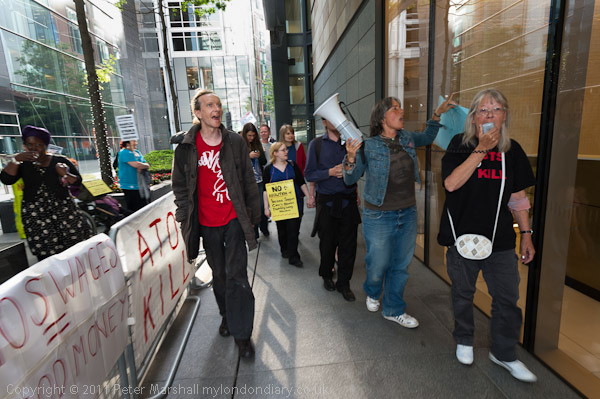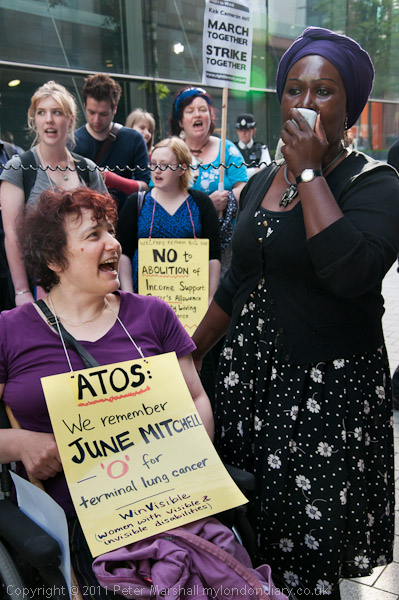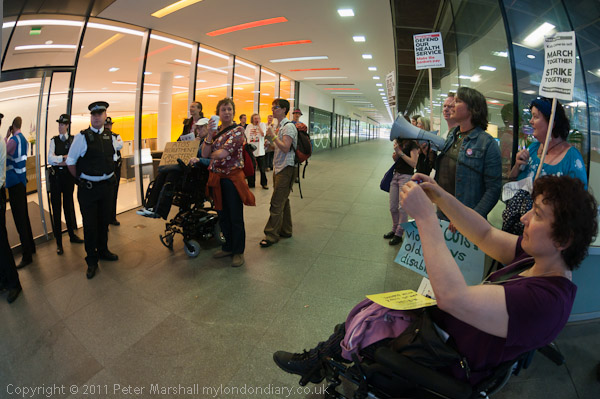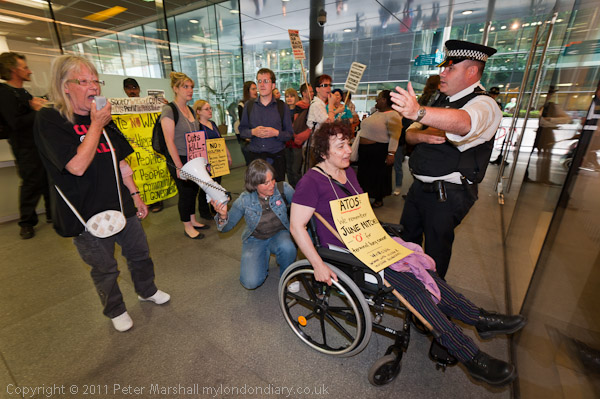This was the third protest outside the Triton Square offices of Atos Healthcare, the company that run computer-based fitness for work tests for the government, who have caused huge distress to many disabled people.
There is something of a Catch-22 about the whole situation. If you can get to the job centre to attend for the test, then clearly you could also get to work, and if you don’t manage to get there you will be penalised for not attending…. Never mind that it might have needed you to organise friends to help you to get there or that it may take you several days to recover.
The tests that Atos don’t really look at the capabilities of the individuals but use a series of stock questions and force the person conducting the test to choose a stock answer, when there may really be nothing that really matches the person in front of them. Rather than a proper medically based test it is a matter of ticking boxes on a computer screen, and although some kind of medical experience is demanded of those carrying them out it may not be in an appropriate area to the person being tested. Someone who has worked with sports injuries may well be assessing people with mental health problems.
You can read more about these tests and the drastic effects they have had on some of those who have been failed by them on My London Diary in Atos, Giz A Job! and my earlier posts.
At one of the previous demonstrations here, one of those who spoke was the sister of a man who had committed suicide when the tests failed to recognise his mental health issues, and one of the protesters at this event carried a placard about a woman with terminal cancer who was given zero points – no disability – at an Atos test. 70% of those who appeal the decisions have their appeals upheld, an alarming failure rate.
The lighting outside the offices, with bright sun in the canyon between tall glass-faced buildings was in places fairly dramatic, with patches of bright sun and reflected sunlight in otherwise quite deep shadow.

You get some idea of the problem in this picture, where fill flash and considerable Lightroom magic has managed to bring the RAW file down to the output range of an image, with just a little loss of highlight detail at top centre. I quite like the challenges of tricky lighting, which tend to result in more interesting images, but at times it was difficult to avoid excessive flare.
As usual, some of this time I was shooting with my personal extended lens hood, otherwise known as my left hand, held above the lens. The built in hood on the 16-35 is as would be expected, almost useless, having to cope with such a wide angle of view, and that on the 18-105, although better is still not very effective.
It’s in this situation that you notice that the optical viewfinder has a slightly smaller view than the camera actually takes (I think according to the manual, which I can’t be bothered to find, showing around 95% of the images. So quite a few of the actual images taken in this way – looking through the viewfinder to see the increase in contrast when you are shading the lens from the sun – turn out to need a little cropping along the top edge where my fingers show in the image but not in the viewfinder.

As you can see there is still some flare in this and some other images. Occasionally things like this green spot can add to images, but usually they just look odd. I’ve toned this down to some extent, but perhaps might also have desaturated it a little more. I wouldn’t want to remove it completely, as it and its less obvious near neighbour perhaps do give a little of the impression of the light conditions (along with the greatly toned down bright area of pavement at bottom right.) But I would see no ethical problem in removing flare spots which are generally not apparent in the actual view you are photographing.
Most of the protest was taking place in the shadows, and there was little excitement about the event, though things became more interesting when the protesters decided to go for a ‘walk’, making their way around the barriers provided by the police into the passageway through the building past the office reception area. Light was lower here, provided by lighting in the ceiling and coming through the glass windows of the offices, and was also of varying colour, greener from the overhead lighting and rather orange from that indoors.
I wasn’t entirely happy with the pictures I was getting in this fairly confined space from the 16-35mm with the D700, and when the protesters went back later I decided to try using the 10.5mm fisheye on the D300. As always it was a strange beast to use, but I think it did the job pretty well.

I got very close to Clare as she raised her camera at arms length in front of her to take this image, trying hard to keep the camera more or less upright. The picture is very slightly cropped at the right and top, and also I’ve corrected the curvature slightly – perhaps around 10-20% in Lightroom. The horizontal angle of view is around 140 degrees and I’ve managed to include both the faces of the group of demonstrators on the right and the police and security outside the revolving door at left.
It doesn’t include all the protesters – they continued in a rough circle behind me , and in a perfect world perhaps the placards at the right would have been about this event and not for other protests, but that’s how things were. But there is something here about the curving lines that brings this image together for me, whereas the rectilinear distortion you get with the 16-35 at 16mm as in the image below seems to sweep things away at the edges.
